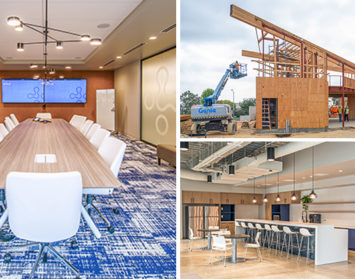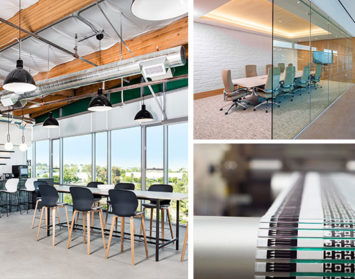The extenuating factors creating a historical economic environment.
We’ve looked back at the first half of 2017 in amazement. As notable larger projects finish up, architectural, engineering, and contracting firms are excited to pursue new opportunities to fill their backlogs. But where there’s more opportunity and successfully awarded projects, so there is increased labor and material demands. While contractor fees and the majority of material prices remain competitive, labor shortages and unknown economic factors have become the industry’s new Achilles heel.
Mega projects on both coasts are pushing ahead. In San Francisco we’re seeing billion-dollar projects get the thumbs-up, like the $8 billion San Francisco Shipyard and Candlestick Redevelopment project. On the other coast, New York City and greater, the billion-dollar Hunters Point South project, Pacific Park project, and Greenpoint Landing in Brooklyn are proceeding.
Although the billion-dollar mega projects are incredibly attractive, they also aren’t for everyone. Rest assured, there isn’t a shortage of the $50 million to $100 million projects. Smaller architectural, engineering, and contracting firms are finding more project volume in smaller national submarkets like San Diego, where the entire county is ripe with hundred million dollar ventures like the Viejas Casino expansion project, the BioLegend Campus Project, and The Think Campus at Millenia Office in Chula Vista.
You can see project prospects are plenty, but with an unemployment rate that’s historically low, firms have to be more selective with the projects they pursue. In the past, firms could staff projects with their existing workforce or fill open positions fairly quickly. But, as we’ve seen most recently, a number of firms have made the decision to not respond to Requests for Proposals (RPFs) altogether, and to only pursue work if it’s on a negotiated basis.
Earlier this year Hughes Marino sent RFPs to eight different general contracting firms for an 80,000 SF, $15 million, high-end creative office and intense laboratory project–a once highly attractive project. Of the eight firms, we received three proposals. The other five firms declined to bid stating they didn’t have the workforce to responsibly complete the project, or have enough time to find the correct personnel to staff the project. A responsible, yet unfortunate result of a raging economy.
Subcontractors aren’t immune to the shortage either. Union and non-Union firms across all trades are finding it increasingly difficult to staff their projects. Most recently in Southern California, a local subcontracting firm reported the Painters and Allied Trades Union expressed that they’re fresh out of workers to send to projects. Similarly, a local glazing subcontractor rejected an RFP for a $15 million glazing package stating they aren’t bidding anymore work until 2018 because they’re too busy.
The numbers don’t lie. Released on July 7th, the latest monthly employment report from the department’s Bureau of Labor Statistics showed that construction’s June jobless rate declined 0.8%, from May’s 5.3% to 4.5%. Offering another perspective, Ken Simonson, AGC’s chief economist, said in a statement, “Construction firms added employees over the past year at nearly double the rate of the overall economy, but the record-low unemployment rate for construction workers shows companies are having to reach outside the industry to fill positions.” What about architectural and engineering firms? Architectural and engineering services watched its workforce increase by 5,400 positions in June.
Until the labor shortage is fixed or spending is slowed, firms will need to either use their already swamped workforce to complete typical project tasks, pursue joint-venture opportunities, or invent and invest in new prefabrication methods hoping to offset overhead expenditures and scheduling conflicts. All tactics that require more time and money, if they can afford it.
As some firms struggle to staff their impressive backlog commitments, companies across all industries remain focused on long-term interest rates, the unemployment rate, and the new Administration’s proposed national budget. Right now, long-term interest rates and the unemployment rate are historically low. We’ll see how long this lasts, but one can’t expect both rates to remain this low forever.
One piece of the equation that might tip the scale is the new Administration’s national budget. Proposing to commit roughly $200 billion over a 10-year period to infrastructure upgrades, the budget also proposes to significantly cut funding in scientific research, an impact that could have a significant impact on secondary industries. Institutions and foundations like the National Science Foundation, the U.S. Centers for Disease Control and Prevention (CDC), and the National Institute of Health (NIH) could see their budgets decrease by as much as 20%. In cities like San Diego, San Francisco, Boston and the Research Triangle in North Carolina where biotech and life science companies rely on grants from these institutions to fund the overhead and research of their labs, significant budget cuts could bankrupt their research altogether. And if the research doesn’t continue, then real estate requirements decrease, and capital commitments for retraction, expansion or stagnation go away altogether. Time will tell if the budget cuts actually happen, and if so, if private investment dollars will make-up for the amount of lost funding.
One characteristic is certain: we’re living in an ever-changing, interesting time. You can bet the cyclical economy will be impacted by extenuating circumstances. Yes, we are experiencing a labor shortage, but if you create an efficient project plan you will be able to set realistic expectations despite the current historical economic factors. On existing projects, it’s a good time to check-in with your entire team to reconfirm workload and schedule commitments. If you’re planning for an upcoming project, start early and include budget and schedule contingencies in your project plan. If you’re running a company, weather your workload and overhead. Although the economy is progressing aggressively, in states like California where the real estate industry and market anchor the bloom and bust economy, the market could change swiftly and reversing the damage would be like turning a barge ship, you’ll need to start early and weather the long ride.
Hughes Marino’s industry leading Program, Project and Construction Management team has unmatched expertise in every type of commercial building project from tenant improvements to ground-up build-to-suits. With decades of experience, our project managers, engineers and LEED APs offer practical insights for the construction management professional.










